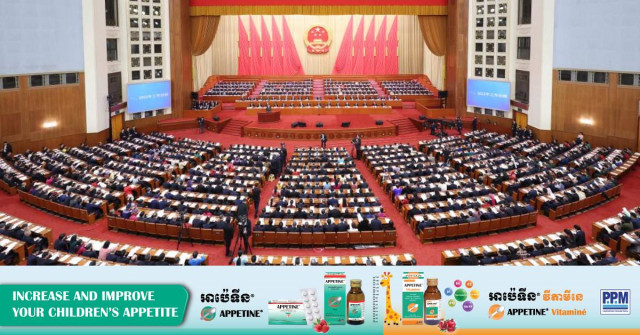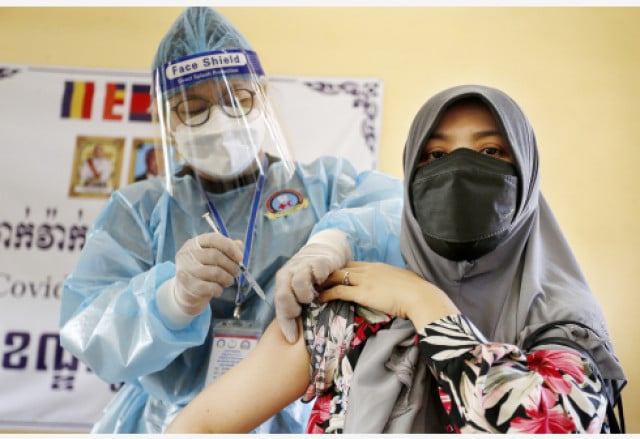China’s National People’s Congress: Implications for Cambodia

- By Sok Sothearak
- March 29, 2024 10:50 AM
The week-long meeting of the 14th National People’s Congress —China’s parliament—ended last week with a break with tradition and a gloomy economic prospect. The traditional post-meeting press conference by the Chinese premier was not hosted this year, and President Xi Jinping did not give a speech at the closing ceremony.
Although the annual meetings of the National People's Congress are primarily ceremonial, they provide a platform through which the ruling Communist Party conveys its policy messages. In this year’s meeting, China’s Premier Li Qiang revealed a GDP growth target of 5 percent for 2024. This is lower than the 5.2 percent GDP growth rate in 2023 but more ambitious than the World Bank’s 2024 forecast of 4.5 percent. Nonetheless, this shows a pessimistic growth prospect for China, facing issues such as a problematic real estate sector, sluggish global demand, and tensions with the West.
During the meeting, measures were implemented to curb property sector risks, cut wasteful spending, and address industrial overcapacity. Crucially, Beijing planned to issue $139 billion worth of ultra-long-term bonds. However, the fiscal deficit was pushed down to 3.8 per cent last year to 3 per cent of GDP, signalling an effort to discipline fiscal stimulus.
These measures are implemented in a fragile property market, with investment falling by 9% and many developers defaulting on debt, including two major players, Evergrande and Country Garden. As one of the main sectors driving growth in the last decade, the Chinese property market is steered towards less risky behaviour and manageable growth after years of highly leveraged real estate models based on debt financing and pre-sale revenue.
“Those that must go bankrupt should go bankrupt or be restructured,” said the Chinese Minister of Housing and Urban-Rural Development of Chinese property developers with ballooning debt. The country is also switching its economic pillar toward new technologies and the innovation sector, believing it will sustain self-sufficiency and economic growth.
What do all these developments mean for Cambodia? For starters, Cambodia's economic growth has been dependent on China. Two-thirds of Cambodia's foreign direct investment (FDI) inflow came from China. Approximately 90% of Cambodian garment factories, the country’s major exporter, are Chinese-owned. China has also been Cambodia’s biggest creditor. In 2023, the Chinese lent Cambodia $4.1 billion or about 37 percent of the kingdom’s total public debt. Major infrastructure projects such as the first expressway and the two new airports in Phnom Penh and Siem Reap are funded by Chinese loans. In addition, more than half a million Chinese tourists visited the country in 2023. This accounted for 10 percent of the total international tourists. The number was much more significant before Covid-19.
The outcomes of the 14th National People’s Congress meeting have four implications for the Cambodian economy. Firstly, despite the Chinese central bank’s interest rate cut on mortgages, a shaky real estate sector, and the willingness of the Chinese government to streamline the undisciplined property developers, investors still need to be confident in this sector. This lack of confidence is contagious and will spread to Cambodia’s real estate. The Chinese had heavily invested in the country's property development before Covid-19. Thus, with Chinese investors’ lack of confidence in property investment generally, Cambodia should expect the continued absence of Chinese capital in this sector for some time. This contrasts the optimism for rebound some Cambodian developers had hoped for. However, FDI in the manufacturing industry might increase.
As Beijing has had trade and political tensions with the West, a lot of Chinese companies are trying to de-risk by relocating their production plants outside of China. This so-called de-risking has taken place since the Covid-19 pandemic. Southeast Asia has emerged as an attractive destination for Chinese manufacturers. That is why we saw a remarkable increase in Chinese solar panel producers in Cambodia in the last few years. Moreover, as noted in the NPC meeting, China focuses on highly technological industries, and Cambodia should expect a higher inflow of low-tech manufacturers. However, the kingdom must compete with neighbouring countries such as Vietnam and Thailand to attract Chinese investors. Secondly, the inflow of Chinese loans to Cambodia will remain the same. The loan will remain stable at around $4 billion per annum.
It might increase due to Cambodia's growing need to finance mega-infrastructural projects such as the Funan Techo canal and the expressway to the Cambodia-Thailand border. Given that the Chinese property sector needs more liquidity, it might sound strange to say bilateral lending will not deteriorate. The main reason is that China's benchmark lending rate (the 1-year loan prime rate) is at its lowest (3.45 percent) since 2019 and will likely remain unchanged this year.
A gloomy domestic property sector makes government-backed overseas infrastructure projects attractive to state-owned Chinese banks. In addition, overseas infrastructure investment is also an opportunity for China to alleviate its industrial overcapacity, as China-funded projects in Cambodia are usually built by Chinese state-owned companies (and labour). Thirdly, constraint fiscal stimulus and deflationary expectations in China might induce a slow growth of Chinese tourist arrival to Cambodia, putting pressure on hospitality businesses in the country.
Thus, the sector must depend on domestic tourism for now. Finally, slow consumption and growth in China might affect Cambodia’s exports. In 2020, Cambodia signed a trade agreement with China to boost bilateral trade. However, Cambodian exports to China still experience slow growth.
The country exported $1.63 billion and imported $13.7 billion of products to and from China in 2022. The kingdom mainly exported food stuff and brought back textile materials and machinery. Dull Chinese consumption will mean lower demand for Cambodian exports. Nonetheless, this might not pose a problem as Cambodian exports to China are meagre compared to another trade partner, the US, which stood at $13 billion in 2022.















